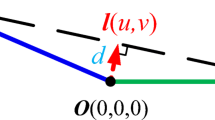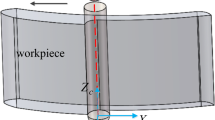Abstract
The cutter runout effect has significant influence on the shape of cutter swept surface and the machining surface quality. Hence, it is necessary to integrate the cutter runout effect in cutter swept surface modeling, geometric error prediction and tool path optimization for five-axis flank machining. In this paper, an envelope surface model considering cutter runout effect is first established, and geometric errors induced by runout effect are derived based on the relative motion analysis between the cutter and part in machining. In the model, the cutter runout is defined by four parameters, including inclination angle, location angle, offset value and the length of cutter axis. Then the runout parameters are integrated into the rotation surface of each cutting edge that is used to form the final cutter envelope surface for the five-axis machining process. Thus, the final resulting geometric errors of the machined surface induced by cutter runout can be obtained through computing the deviations from the nominal cutter swept surface. To reduce these errors, an iterative least square method is used to optimize the tool paths for five-axis flank machining. Finally, a validation example is given for a specific ruled surface. Results show the effectiveness and feasibility of the analytical model of geometric errors induced by cutter runout, and also show that the geometric errors can be reduced significantly using the proposed tool path planning method.
Similar content being viewed by others

References
Ding H, Zhu L M. Global optimization of tool path for five-axis flank milling with a cylindrical cutter. Sci China Ser E-Tech Sci, 2009, 53: 2449–2459
Gong, H, Wang N. 5-axis flank milling free-form surfaces considering constraints. Comput Aided Des, 2011, 43(6): 563–572
Zhu L M, Ding H, Xiong Y L. Third-order point contact approach for five-axis sculptured surface machining using non-ball-end tools (I): Third-order approximation of tool envelope surface. Sci China Tech Sci, 2010, 53: 1904–1912
Zhu L M, Ding H, Xiong Y L. Third-order point contact approach for five-axis sculptured surface machining using non-ball-end tools (II): Tool positioning strategy. Sci China Tech Sci, 2010, 53: 2190–2197
Lartigue C, Duc E, Affouard A. Tool path deformation in 5-axisflank millingusing envelope surface. Comput Aided Des, 2003, 35(4): 375–382
Bi Q Z, Wang Y H, Zhu L M, et al. Wholly smoothing cutter orientations for five-axis NC machining based on cutter contact point mesh. Sci China Tech Sci, 2010, 53: 1294–1303
Zhang X M, Zhu L M, Zheng G, et al. Tool path optimization for flank milling ruled surface based on distance function. Int J Prod Res, 2010, 48(14): 4233–4251
Desai K A, Agarwal P K, Rao P V M. Process geometry modeling with cutter runout for milling of curved surfaces. Int J Mach Tool Man, 2009, 49(12–13): 1015–1028
Sun Y W, Guo Q. Numerical simulation and prediction of cutting forces in five-axis milling processes with cutter run-out. Int J Mach Tool Man, 2011, 51(10–11): 806–815
Mao X Y, Liu H Q, Li Bin. Time-frequency analysis and the detecting method research on the milling force token signal in the spindle current signal. Sci China Ser E-Tech Sci, 2009, 52: 2810–2813
Weinert K, Du S, Damm P, Stautner M. Swept volume generation for the simulation of machining processes. Int J Mach Tool Manu, 2004, 44: 617–628
Zhu L M, Zhang X M, Zheng G, et al. Analytical expression of the swept surface of a rotary cutter using the envelope theory of sphere congruence. J Manuf Sci E-T ASME, 2009, 131(4): 041017
Larue A, Altintas Y. Simulation of flank milling processes. Int J Mach Tool Man, 2005, 45(4–5): 549–559
Zhang X J, Xiong C H, Ding Y, et al. Variable-step integration method for milling chatter stability prediction with multiple delays. Sci China Tech Sci, 2011, 54: 3137–3154
Ahmadi K, Ismail F. Machining chatter in flank milling. Int J Mach Tool Man, 2010, 50(1): 75–85
Wang W P, Wang K K. Geometric modeling for swept volume of moving solids. IEEE Comput Graph Appl, 1986, 6(12): 8–17
Sheltami K, Bedi S, Ismail F. Swept volumes of toroidal cutters using generating curves. Int J Mach Tool Man, 1998, 38(7): 855–870
Blackmore D, Leu M C, Wang L P. The sweep-envelope differential equation algorithm and its application to NC machining verification. Comput Aided Des, 1997, 29(9): 629–637
Aras E. Generating cutter swept envelopes in five-axis milling by two-parameter families of spheres. Comput Aided Des, 2009, 41(2): 95–105
Liu X W. Five-axis NC cylindrical milling of sculptured surfaces. Comput Aided Des, 1995, 27(12): 887–894
Bedi S, Mann S, Menzel C. Flank milling with flat end milling cutters. Comput Aided Des, 2003, 35(3): 293–300
Senatore J, Monies F D R, Redonnet J M, et al. Analysis of improved positioning in five-axis ruled surface milling using envelope surface. Comput Aided Des, 2005, 37(10): 989–998
Gong H, Wang N. Optimize tool paths of flank milling with generic cutters based on approximation using the tool envelope surface. Comput Aided Des, 2009, 41(12): 981–989
Zhu LM, Zheng G, Ding H, et al. Global optimization of tool path for five-axis flank milling with a conical cutter. Comput Aided Des, 2010, 42(10): 903–910
Li X P, Li H Z. Theoretical modelling of cutting forces in helical end milling with cutter runout. Int J Mech Sci, 2004, 46(9): 1399–1414
Author information
Authors and Affiliations
Corresponding author
Rights and permissions
About this article
Cite this article
Guo, Q., Sun, Y. & Guo, D. Analytical modeling of geometric errors induced by cutter runout and tool path optimization for five-axis flank machining. Sci. China Technol. Sci. 54, 3180–3190 (2011). https://doi.org/10.1007/s11431-011-4606-7
Received:
Accepted:
Published:
Issue Date:
DOI: https://doi.org/10.1007/s11431-011-4606-7



